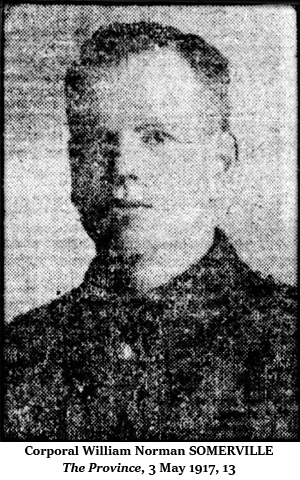Private John William SAYERS
Regimental Number: 645154
Enlistment Date / Location / Unit: 10 January 1916 / Vancouver, BC / 158th Battalion
Birth Date / Location: 23 October 1894 / Dublin, Ireland (1895 on Attestation)
Parents: George Fischer Holford Sayers and Susanna Elizabeth Poet
Occupation on Enlistment: Deck hand
Date of Death / Location: 7 November 1917 / Belgium
Age at Death: 23
Unit on Date of Death, or on Demobilization: 24th Battalion
Circumstances of Death: Killed in Action at Passchendaele
Cemetery or Memorial: Menin Gate Memorial, Ypres, Belgium. Panel 26
Medals / Awards: British War Medal, Victory Medal
Where commemorated: First World War Book of Remembrance page 322, Memorial Chamber, Parliament Buildings, Ottawa, ON; Maple Ridge Cenotaph, Maple Ridge, BC; St John the Divine Anglican Church Memorial Plaque, Maple Ridge, BC; Menin Gate Memorial, Ypres, Belgium; Municipality of Maple Ridge Honour Roll, St John the Divine Anglican Church, Maple Ridge, BC
John “Jack” William Sayers was the son of George Sayers and Susanna Elizabeth (nee Poet) Sayers, born 23 October 1894 in Dublin, Ireland; he had one brother. His family immigrated to Canada on the Empress of Ireland in June of 1910, and were living in Maple Ridge in 1911. Paternal uncle Herbert Sayers and his family were living with the family in 1911 census.
John enlisted in the Canadian Expeditionary Force, 158th Battalion, 10 January 1916 in Vancouver, BC, at the age of 22. On enlistment he presented as 175 centimetres (5 feet 9 inches) tall, 72 kilograms (158 pounds), fair complexion, blue eyes and fair hair, his occupation was noted as a deck hand. His father was a gardener.
Jack arrived in England on 22 November 1916 with the rank of Acting Corporal. He reverted to Private on 18 February 1917 in order to proceed overseas. Following several transfers of short duration he was taken on strength by the 24th Battalion and arrived in France on 28 May 1917. He was killed in action, in the trenches at Passchendaele on 7 November 1917, at the age of 23.
In the 18 March 1918 edition of the Vancouver Daily World it was written of Jack Sayers, “During his residence in Vancouver he was employed on the government dredge and took a very active part in the Vancouver Cyclists’ Corps. He was considered by many to be one of the fastest men that Vancouver has had in recent years on the racing path and won every race he competed in at the meetings promoted by that organization.” After his death, which was reported late, it also quoted that “his Captain, in a letter he wrote to his parents, spoke highly of his qualities as a soldier and of his bravery.” News of his death “came as a sad blow to his many cycling friends who looked upon him as one of the best of cycling chums and one of the best fellows.”
His parents and brother left Canada in the fall of 1915 and settled in California. Herbert and his family continued to reside in the Lower Mainland. They were members of the congregation of St. John the Divine. Herbert and his wife are buried in the Maple Ridge Cemetery.
J. Sayers was added to the Cenotaph sometime after the 1950s.
(Updated 09-Jan-2024)

Corporal William Norman SOMERVILLE
Regimental Number: 16364
Enlistment Date / Location / Unit: 19 September 1914 / Valcartier, QC / 7th Battalion
Birth Date / Location: 12 January 1884 / Arnprior, Renfrew, ON
Parents: Peter Taylor Somerville and Annie Robertson
Occupation on Enlistment: Iron moulder
Date of Death / Location: 27 June 1917 / Orpington, Kent, England
Age at Death: 33
Unit on Date of Death, or on Demobilization: 7th Battalion
Circumstances of Death: Died from gunshot wound to the face sustained at Battle of Vimy Ridge, and meningitis.
Cemetery or Memorial: Orpington (All Saints) Churchyard Extension, Kent, England. Row B, Number 8 Canadian Corner
Medals / Awards: 1914-1915 Star / British War Medal / Victory Medal
Where commemorated: Canadian Virtual War Memorial, Veterans Affairs Canada; First World War Book of Remembrance page 330, Memorial Chamber, Parliament Buildings, Ottawa, ON; Maple Ridge Cenotaph, Maple Ridge, BC; Municipality of Maple Ridge Honor Roll, St John the Divine Anglican Church, Maple Ridge, BC; The Gold Stripe Roll of Honour, Maple Ridge, page 89
William “Norman” Somerville, his parents and five siblings were all born in Ontario. In the 1890s the family moved to Brandon, MB. By 1905 most of the family members were living in Vancouver, BC. Norman was a member of the Mount Pleasant Presbyterian Church athletic club in Vancouver, playing on the lacrosse team.
While Norman and his parents only lived briefly in Maple Ridge before their respective deaths, two of Norman’s four sisters lived in Port Hammond and Port Haney from at least 1919 and for the rest of their lives: Mary Edna (nee Somerville) Vallie and her second husband Hugh George Fossett, and Margaret Isabella Somerville and her husband Wilbert John Ross.
He was with the 6th Regiment of the Duke of Connaught’s Own Rifles for 5 years prior to enlisting. When he enlisted at age 30, Norman was 1.5 meters (5 feet 7 inches) tall and weighed 66 kilograms (146 pounds). The black and white photograph does not show he had red hair and hazel eyes. Prior to enlisting Norman had worked for a few years as an iron moulder for the Great West Smelting and Refining Company in Vancouver, BC.
Norman, and those who enlisted at Valcartier, QC formed part of the First Contingent of Canadian soldiers to go overseas in October 1914. He was transferred to France in February 1915 in time to see action at the Second Battle of Ypres that April, where he received a gunshot wound to the left leg on 28 April. This was the first battle which saw the use of chlorine gas against troops.
In May 1915 Norman received an unknown injury at the Battle of Festubert. When he recovered from his injuries he returned to his unit.
Norman was promoted to Lance Corporal on 1 September 1915. Less than two months later he requested a return to the rank of Private. The next year on 2 October 1916 Norman was again promoted to Lance Corporal, and then promoted to Corporal on 23 November 1916.
The 7th Battalion formed part of the 2nd Brigade during the attack on Vimy Ridge. Here, between 8-10 April 1917, Norman received a gunshot wound to his right ear, resulting in a medical evacuation to Ontario Military Hospital in Kent, England. His condition worsened over the next two months, he developed meningitis, and he died on 27 June 1917.
N. Somerville’s name was on the Cenotaph when it was unveiled in 1923.
(Updated 19-Feb-2024)

Private Alfred SORENSON
Regimental Number: 294372
Enlistment Date / Location / Unit: 19 May 1916 / Vancouver, BC / 196th Battalion
Birth Date / Location: 19 January 1895 / Tromso, Trondhjeim, Norway
Parents: Andreas (Andrew) Edvard Sorensen and Sebine Edine Pedersen
Occupation on Enlistment: Farmer
Date of Death / Location: 26 October 1917 / Passchendaele
Age at Death: 22
Unit on Date of Death, or on Demobilization: 46th Infantry Battalion (South Saskatchewan)
Circumstances of Death: Killed in action
Cemetery or Memorial: Menin Gate Memorial, Ypres, Belgium
Medals / Awards: Plaque and Scroll, British War Medal, Victory Medal
Where commemorated: Canadian Virtual War Memorial, Veterans Affairs Canada; First World War Book of Remembrance page 330, Memorial Chamber, Parliament Buildings, Ottawa, ON; Maple Ridge Cenotaph, Maple Ridge, BC; Menin Gate Memorial, Ypres, Belgium; Municipality of Maple Ridge Honour Roll, St John the Divine Anglican Church, Maple Ridge, BC; The Gold Stripe Roll of Honour, Maple Ridge, page 89; Whonnock Lake Centre plaque, Maple Ridge, BC; Whonnock’s Roll of Honour in the C.E.F.
Alfred Sorensen was born 19 January 1895 in Tromso, Trondhjeim, Norway to Andrew Sorensen and Sebine Pedersen. In 1899 Andrew, Sebine and their four young sons immigrated to Australia where their three daughters were born. After the birth of their youngest daughter in 1906, the family returned to Norway before immigrating to Canada in 1910. They settled in Whonnock, BC where the men were salmon fishermen on the Fraser River.
The Sorensen family were lifelong residents of Whonnock; family members are interred at Whonnock Cemetery.
Alfred enlisted in the in the 223rd Scandinavian Battalion in May 1916 at age 21. He gave his occupation as farmer. He had blue eyes and fair hair and stood 1.7 meters (5 feet 8-3/4 inches) tall, weighed 69 kilograms (152 pounds) and had a small scar on his forehead.
On 19 October 1916 he was transferred from the 223rd Battalion to the 196th Battalion. Not long after that he shipped out for England arriving on 11 November 1916 where he was assigned to a reserve unit until his transfer to the 46th Battalion. He arrived in France on 2 February 1917. In August and September 1917 Alfred was training out of the front lines. He rejoined his unit on 26 September 1917 and a month later, on the 26th of October, he lost his life on the first day of the Battle of Passchendaele.
At Passchendaele the 46th Battalion suffered 403 casualties from their strength of 600 men. The unit was known as “The Suicide Battalion” because they had a 92 percent casualty rate in 27 months.
A. Sorenson’s name was on the Cenotaph when it was unveiled in 1923.
(Updated 28 January 2024)

Private Stanley Morris SNELLING
Regimental Number: 129925
Enlistment Date / Location / Unit: 5 October 1915, Vancouver, BC/ 72nd Overseas Battalion (Seaforth Highlanders of Canada), CEF, “D” Company
Birth Date / Location: 29 July 1874/ Borough of Lambeth, Greater London, England (1873 on Enlistment)
Parents: Edward Snelling and Elizabeth (nee Morris) Snelling
Occupation on Enlistment: Storekeeper
Date of Death / Location: 24 November 1916/ No.1 Canadian General Hospital Étaples, France
Age at Death: 42
Unit on Date of Death, or on Demobilization: 72nd Overseas Battalion, CEF
Circumstances of Death: Died of wounds, gunshot wounds to eyes and jaw received in action
Cemetery or Memorial: Étaples Military Cemetery, Row C Plot 20 Departement du Pas-de-Calais, Nord-Pas-de-Calais, France
Medals / Awards: British War Medal; Victory Medal
Where commemorated: First World War Book of Remembrance page 165, Memorial Chamber, Parliament Buildings, Ottawa, ON; Municipality of Maple Ridge Honour Roll, St John the Divine Anglican Church, Maple Ridge, BC; The Gold Stripe Roll of Honour, Maple Ridge, page 89; Whonnock Lake Centre Plaque, Maple Ridge, BC; Whonnock’s Roll of Honour in CEF; Bexhill-on-Sea, England, War Memorial, West Panel; The Scottish National War Memorial Roll of Honour.
Stanley Morris Snelling was born in the Borough of Lambeth, Greater London, England on 29 July 1874 to Edward Snelling, a provision merchant, and his wife Elizabeth (nee Morris). Stanley was the fourth of eight children.
In 1901, Stanley enlisted in the Royal Sussex Regiment, 1st Battalion and was sent to fight in the South African War.
In 1908, Stanley immigrated to Canada aboard the SS Virginian. His destination was listed as Alberta, however he appears to have relocated, shortly after immigrating, to New Westminster, BC where his younger brother Arthur ran a general store in Sapperton. By 1911 Stanley was in business with fellow Royal Sussex Regiment soldier John Aston running the Ideal Grocery Store in Vancouver. In 1912 they own Aston and Snelling Grocers in New Westminster. In 1913 Stanley Snelling is listed on the Maple Ridge Collector’s Roll as owning property in Whonnock. His friend and business partner John Aston owned adjacent property. By 1915 Stanley had a cigar shop on Granville Street in Vancouver. The January 1916, Maple Ridge Collector’s Roll noted “S. M. Snelling at address #129925 Pte S.M Snelling, D Corp 72 Battalion, Hastings Park, Van.”
Stanley enlisted on 5 October 1915 at Vancouver in the 72nd Battalion (Seaforth Highlanders of Canada), CEF, “D” Company. Upon enlistment, Stanley was 1.67 meters (5 feet 6 inches) in height and had light complexion, light blue eyes and brown hair.
In April,1916, Stanley sailed with the 72nd Battalion from Halifax to England on the R.M.S. Empress of Britain. He embarked for France on 12 August 1916. In less than four months, Stanley was dead as a result of gunshot wounds to his eyes and jaw sustained in action on 24 November 1916. His death occurred during the final days of the Battle of the Somme when the 72nd Battalion, as part of the 4th Canadian Division, was assaulting the German position at Courcelette.
Both of Stanley’s brothers served during the First World War. Edward Snelling (1873–1960) enlisted in the 131st Overseas Battalion on 18 January 1916 in New Westminster, BC, as Private, Regimental No. 790411. After the war, Edward returned to BC and settled in Vancouver. Arthur Thomas Snelling (1887-?) enlisted in the Australian Imperial Force, 8th Field Ambulance on 13 September 1915 and served in the Mediterranean until his discharge 11 December 1916 as medically unfit. He returned to New South Wales, Australia after the war.
Stanley’s friend and business partner John Aston (1881–1917) Regimental No. 760352 enlisted 16 November 1915 at Vancouver, BC as a Private in the 121st Overseas Battalion. He died of wounds received in action on 24 April 1917. He left a surviving spouse Victoria Caroline (nee Hamilton) Aston (1896-1973) and two children Charlotte Carol Aston and Margaret Aston.
Although previous research (In Memory of Those who Fell, 2016) identified “Frederick Thomas Snelling” Regimental No. 916316 as the “Snelling” commemorated on the Whonnock Brass Memorial Plaque, no records connect Frederick to the area. Whonnock’s Roll of Honour in CEF produced in 1916, identifies “Snelling, S.M.” although other documents, including the Municipality of Maple Ridge Honour Roll, The Gold Stripe Roll of Honour, and some Maple Ridge assessment and collector’s rolls list Stanley as D.M. Snelling. The 1921 Whonnock Brass Memorial Plaque identifies F.J. Snelling. Despite these inconsistencies, a thorough review of all Snellings who enlisted in the CEF during the First World War was conducted and only Stanley Morris Snelling was found to have ties to the Whonnock community.
(Updated 02 October 2024)

